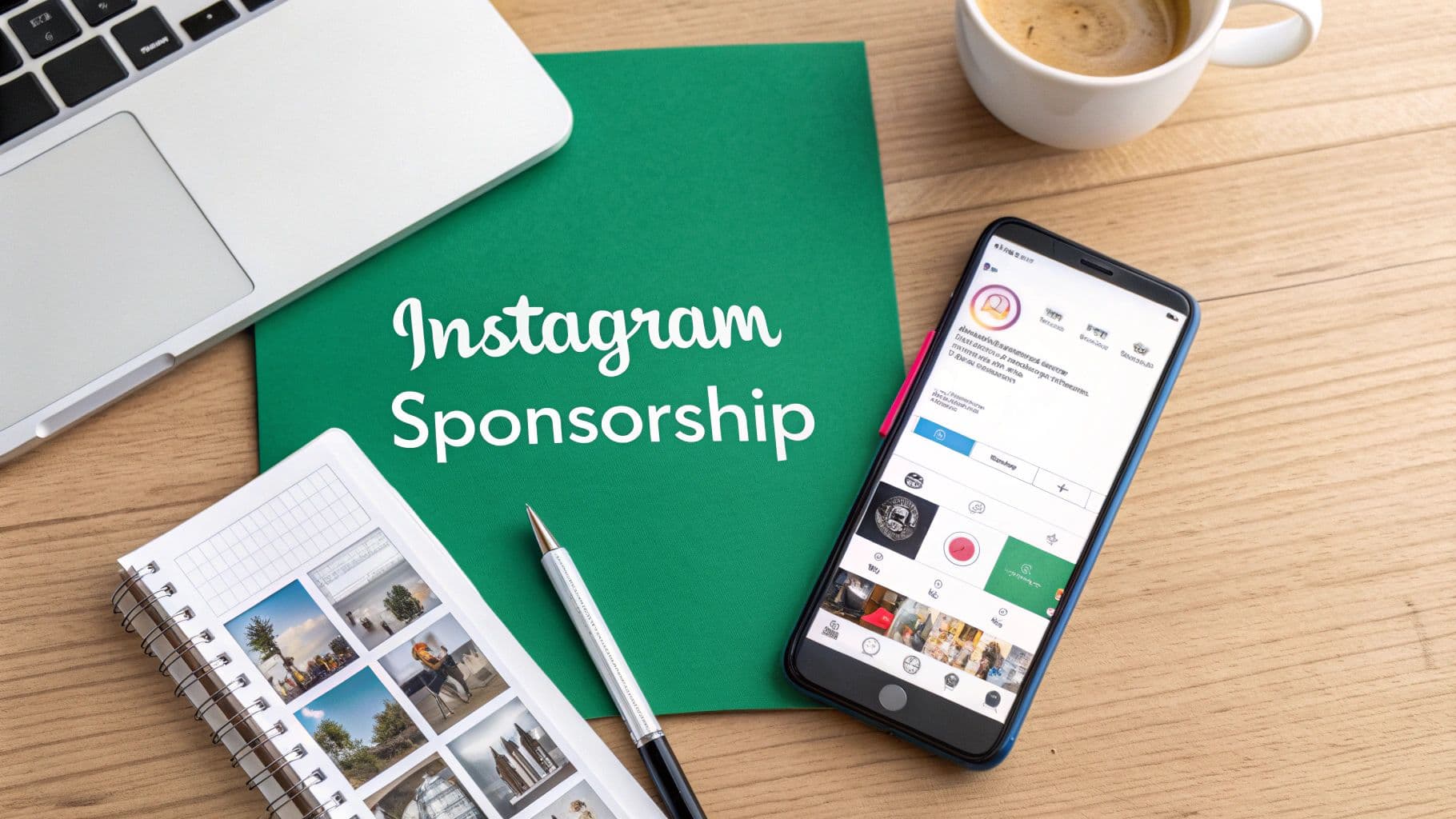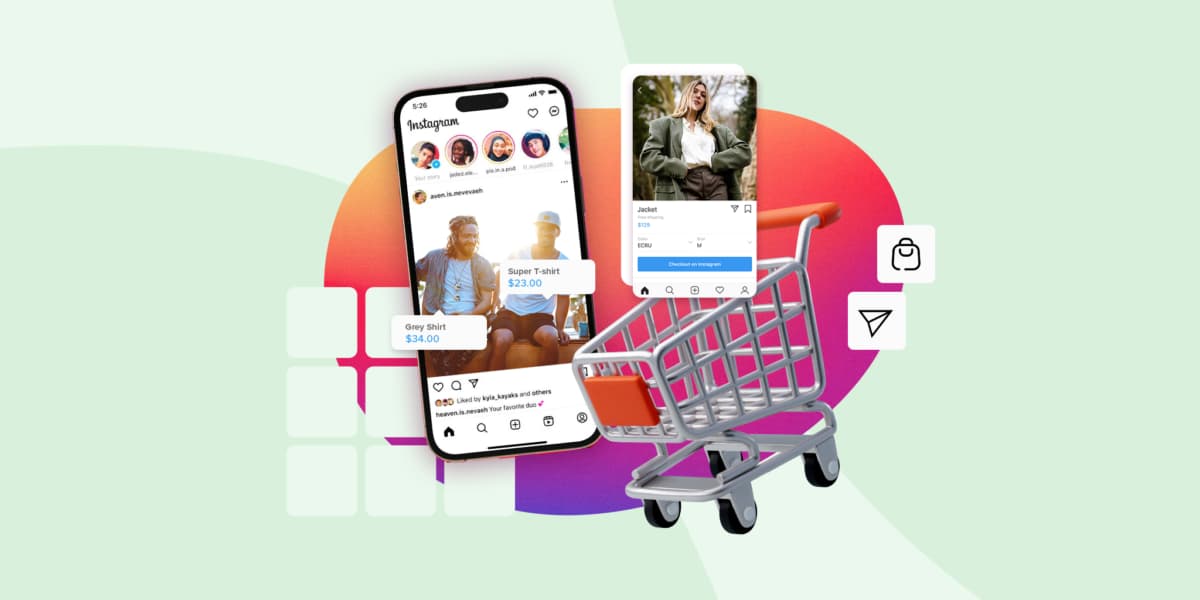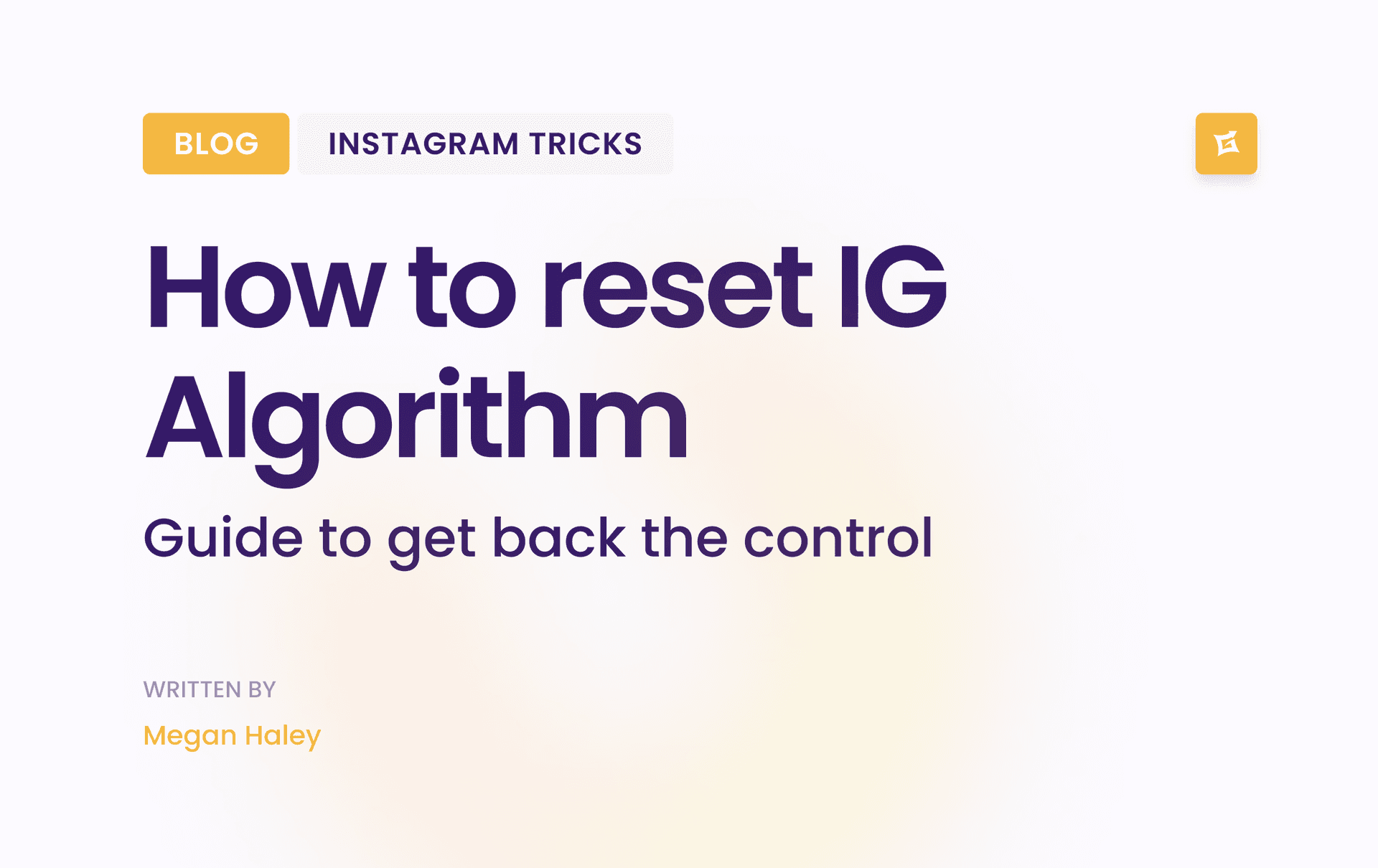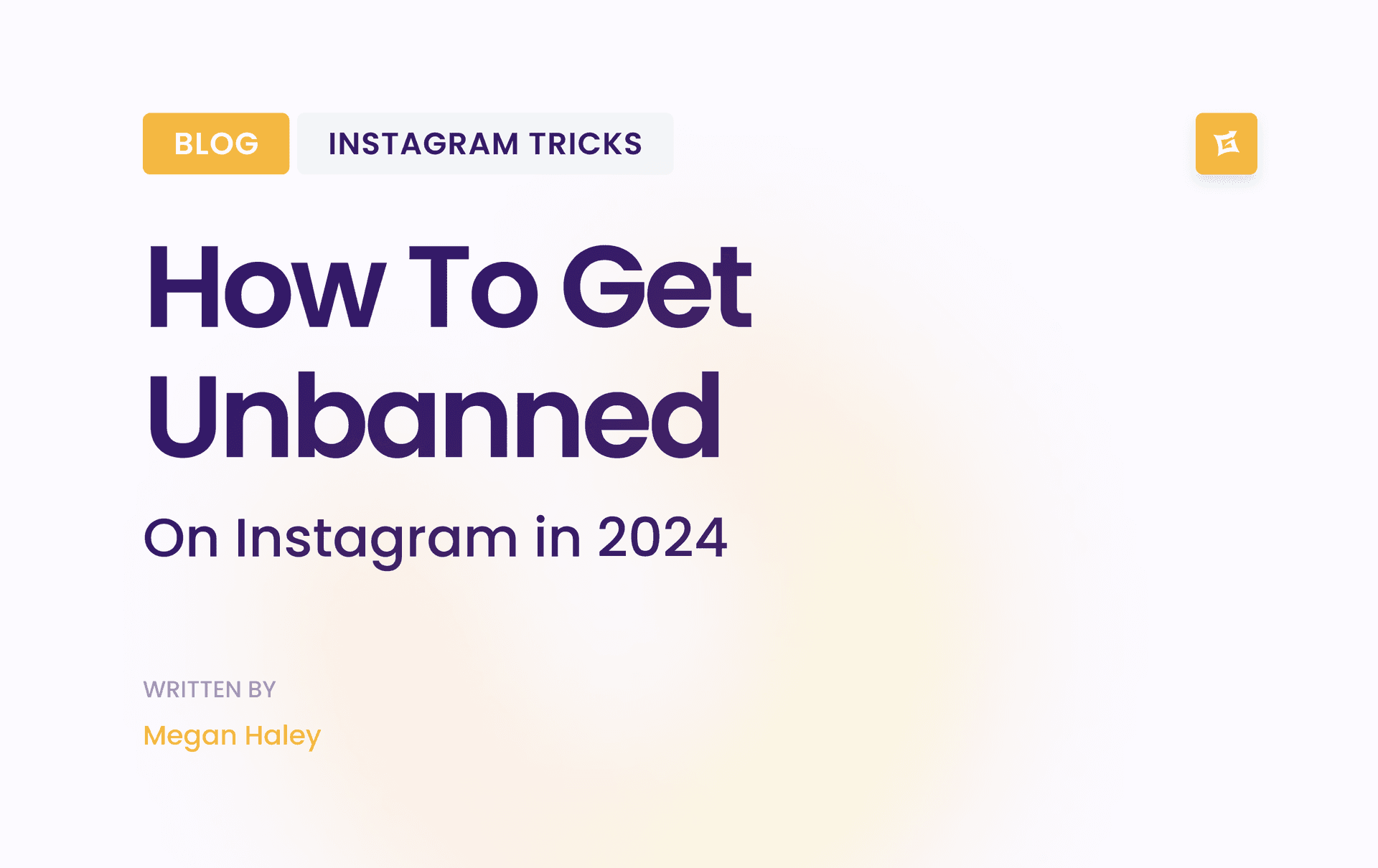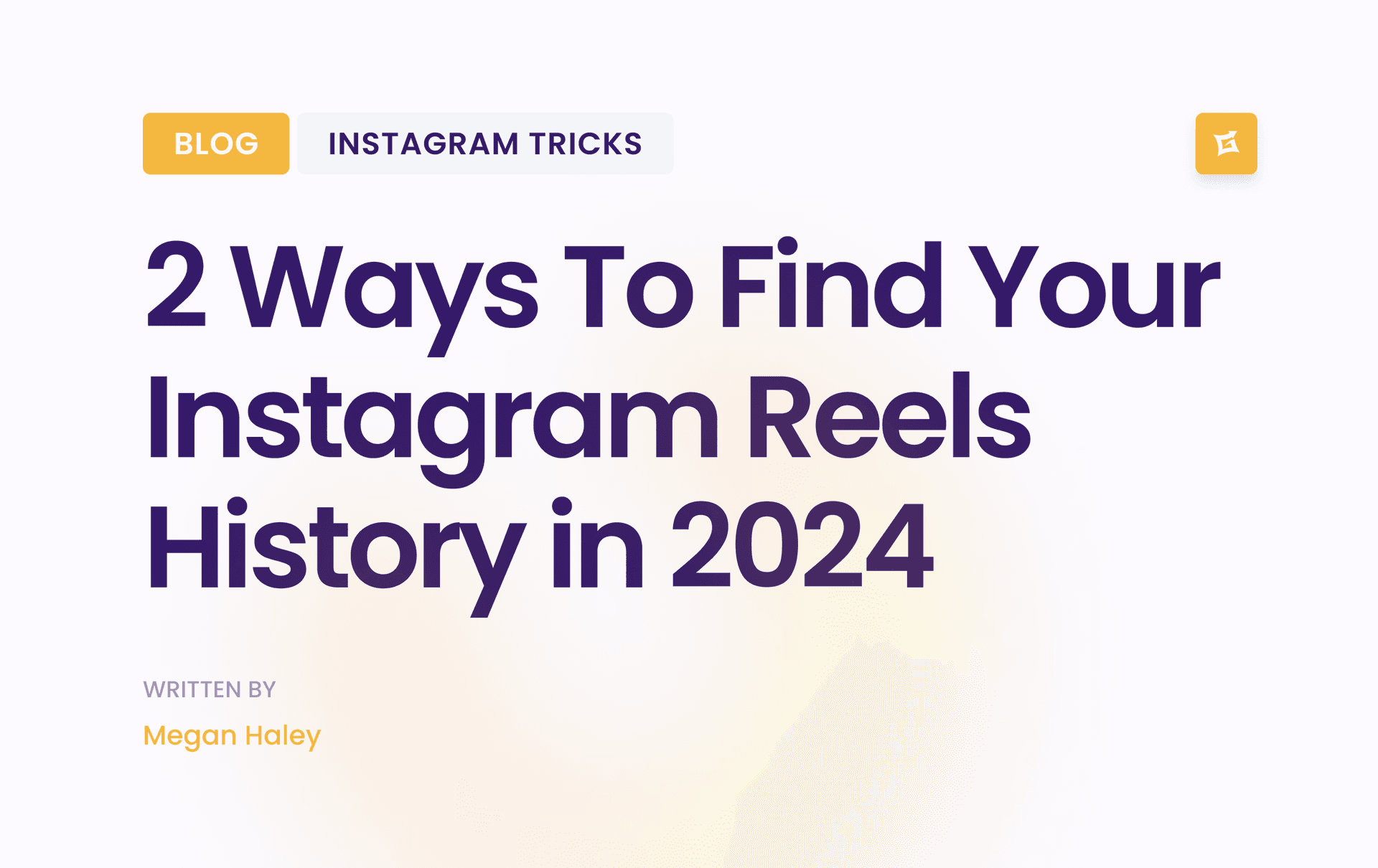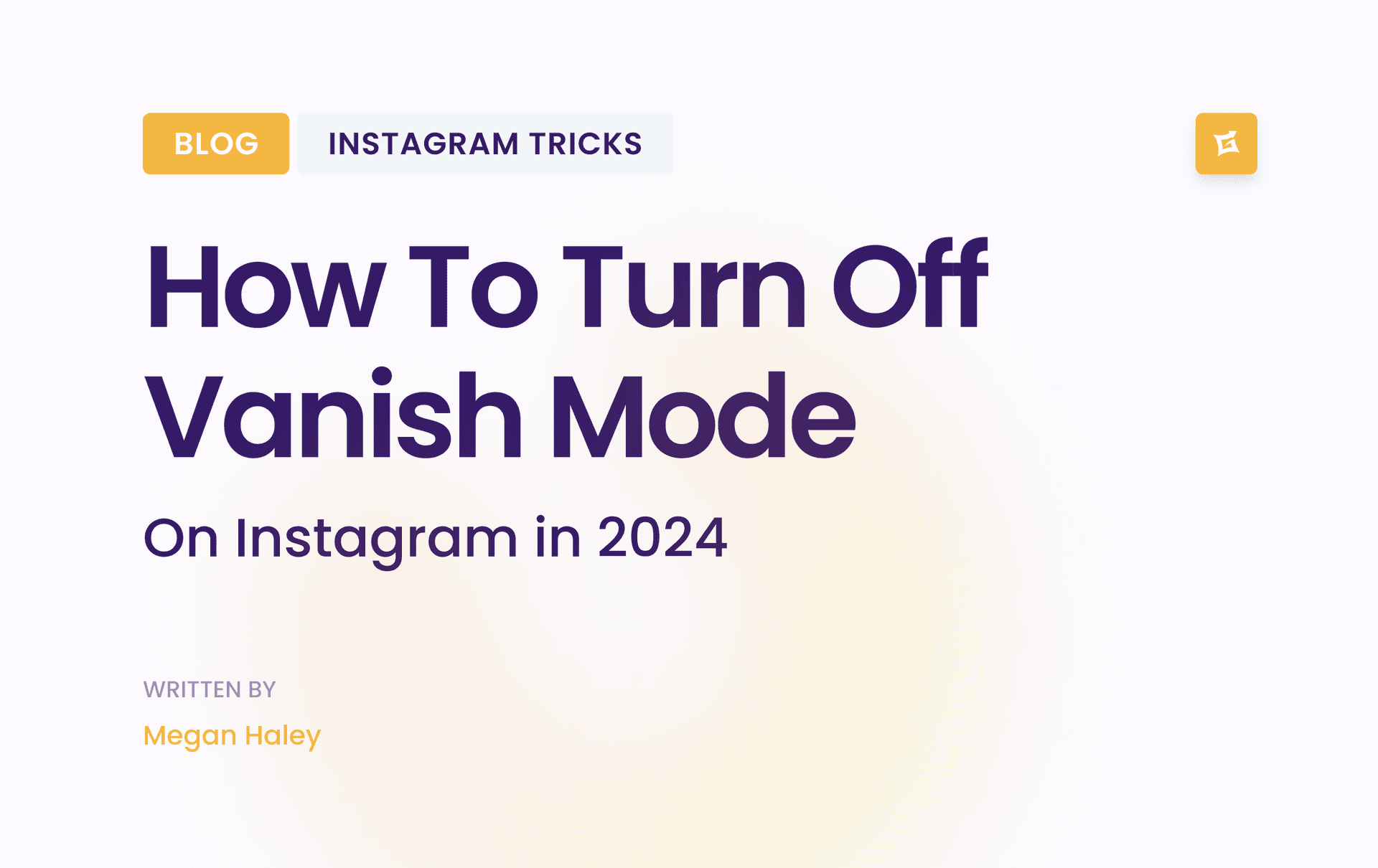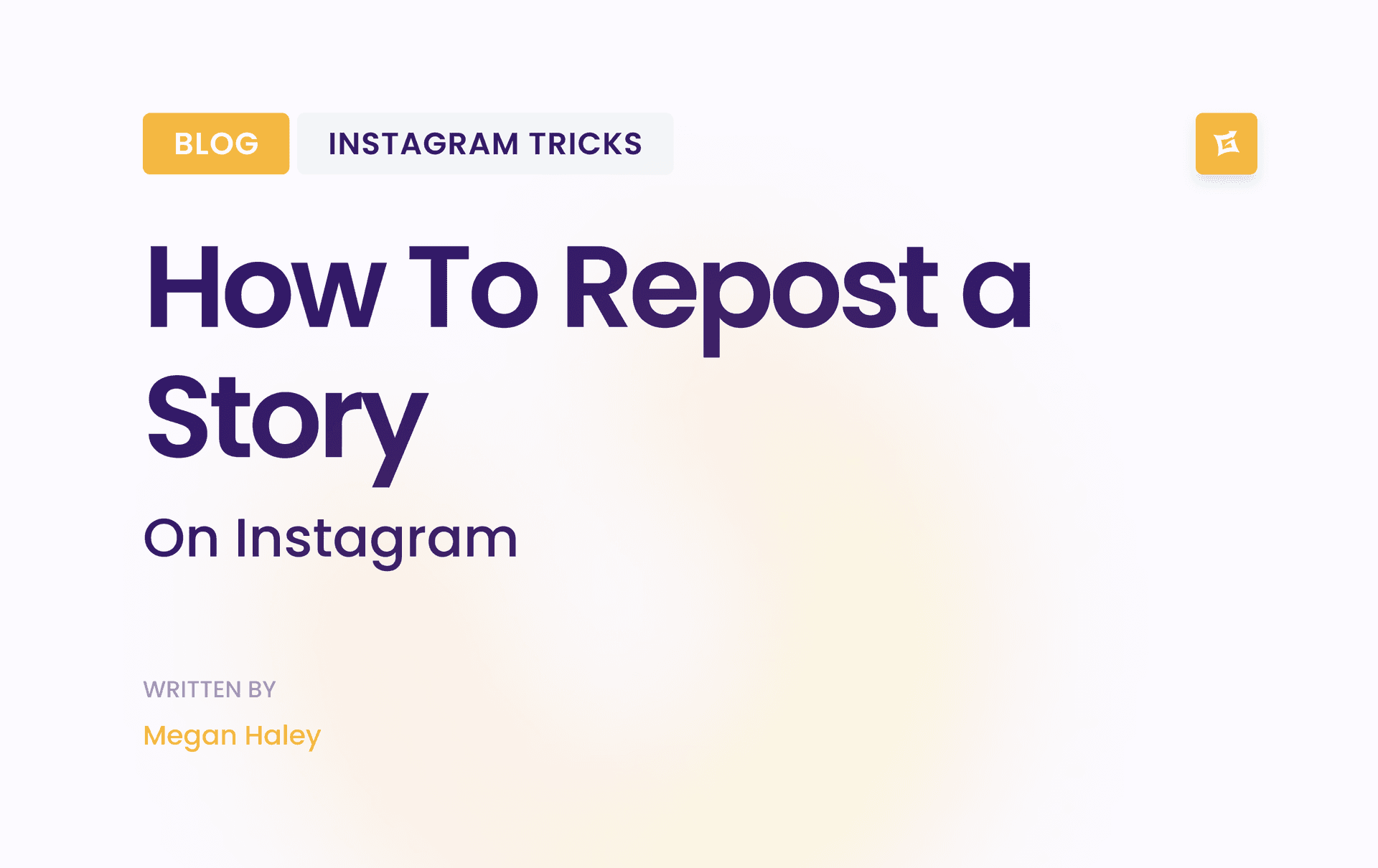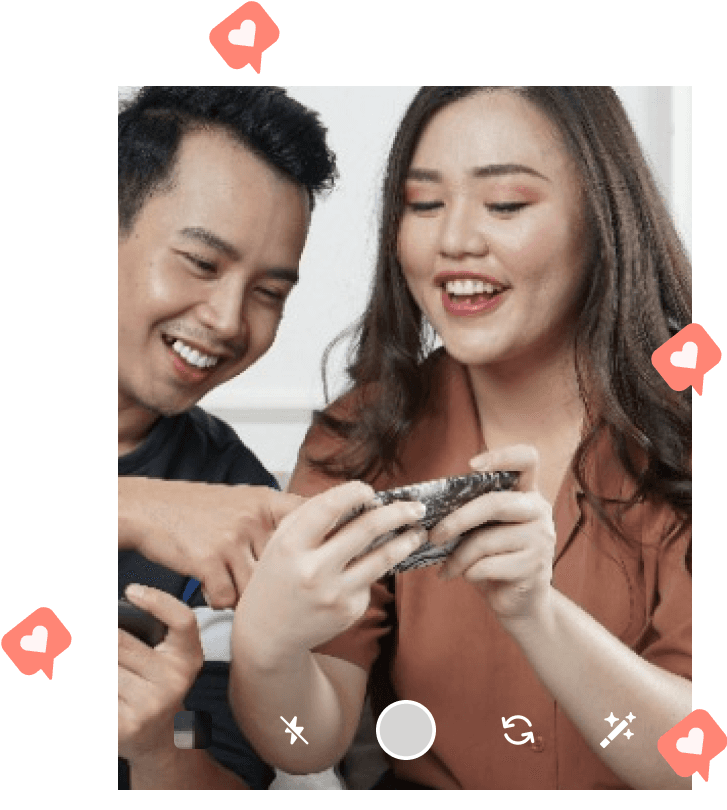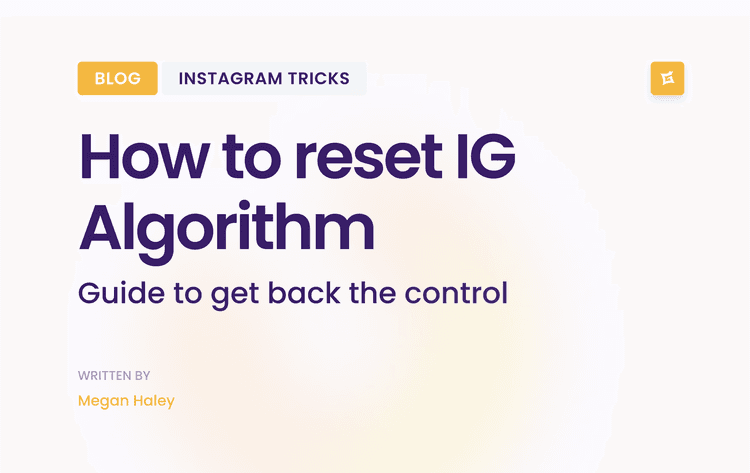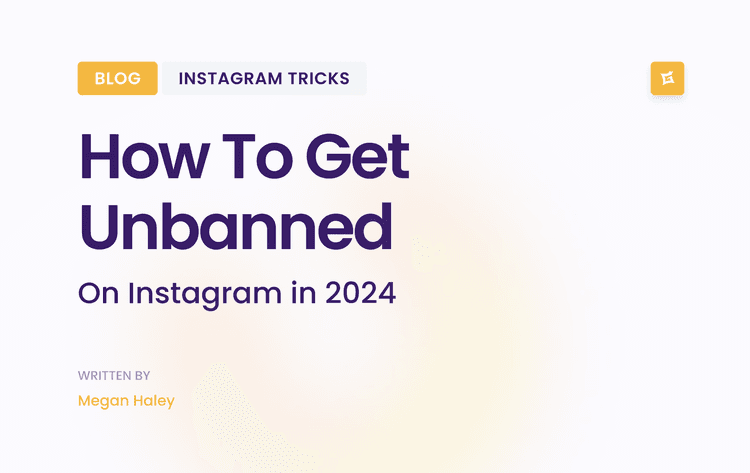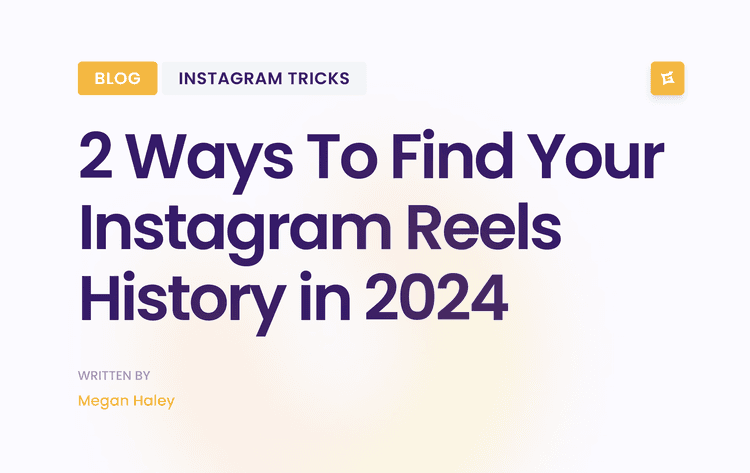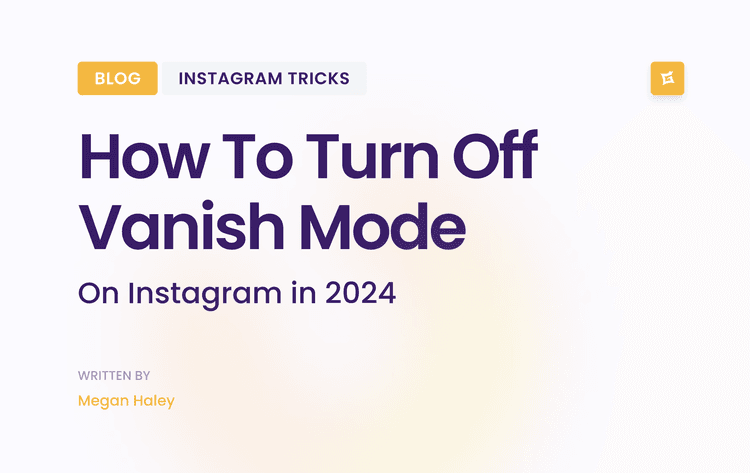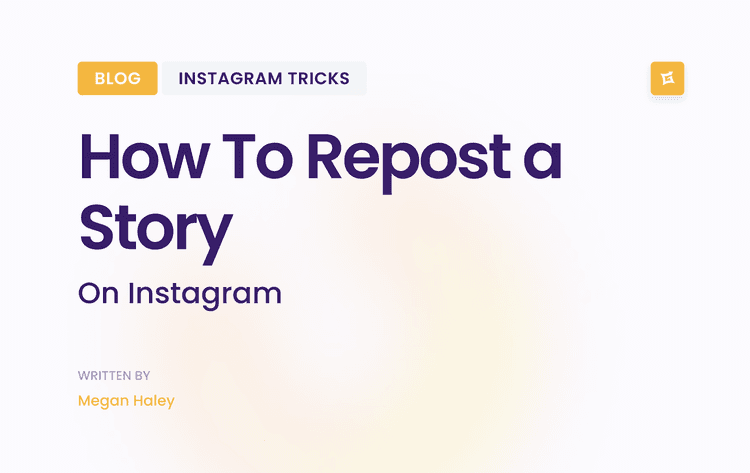Building a Sponsor-Ready Instagram Profile
Think of your Instagram account as your storefront. Before a brand decides to work with you, they're going to walk in, look around, and size things up. They'll scroll through your feed, read your bio, and check out your audience. A big follower count is nice, but what they’re really looking for is a professional creator who knows their own brand and audience inside and out. This is your one shot to make a great first impression.
Define Your Unique Niche
First things first, you need a specific niche. It’s not enough to be a “foodie” or a “traveler.” Are you a vegan home cook who specializes in 30-minute meals? Or maybe a travel blogger focused exclusively on sustainable European adventures?
A tight, focused niche makes it incredibly easy for brands to see if your audience is their target audience. A profile that tries to be everything to everyone just ends up being confusing and much less attractive to a potential sponsor.
> A well-defined niche tells a brand exactly who you reach and why that audience trusts you. It's the difference between being a generalist and becoming an indispensable expert in a specific community.
To really get an edge, it pays to keep up with the evolving world of social media influencers, especially with the rise of AI-generated personalities. Understanding the landscape helps you lean into what makes you unique: your genuine human touch.
Optimize Your Bio for Business
Your bio is your elevator pitch. You have about three seconds to tell a visitor who you are, what you do, and who you help. For a sponsor, that bio needs to be clear, professional, and straight to the point.
Here’s what a solid, business-focused bio includes:
Your Value Proposition: State your niche clearly. Think "NYC Sustainable Fashion" or "Gluten-Free Baking Tips."
Contact Information: Have a dedicated, professional email address for business inquiries right in your bio. Don’t make brands dig for it.
A Clear Call to Action: Use a link-in-bio tool to send people to your portfolio, blog, or, even better, a media kit.
Nailing the bio is a real art form, and it can be the single thing that gets a brand manager to click "contact." For a deeper dive, our guide on powerful Instagram bio tips will help you craft one that really stands out.
Cultivate a Consistent and High-Quality Aesthetic
Brands are looking for creators whose visual vibe aligns with their own. A cohesive, high-quality feed isn't just pretty—it shows you’re a serious professional with a clear creative vision. This doesn't mean every photo has to be identical, but they should all feel connected. Maybe it's a consistent color palette, a specific editing style, or a recurring content theme. Always use high-resolution images and sharp, well-edited videos.
The opportunity on Instagram is massive. We're talking about a platform with over 2 billion monthly active users. Brands are especially keen on the 18-24 year-old demographic, and young women in this age group alone make up 16.4% of Instagram's total audience. On top of that, fashion-related accounts are responsible for a whopping 25% of all brand interactions, showing just how powerful a strong visual niche can be. Your profile has to meet the level of quality these brands are looking for.
How to Find the Right Brand Sponsors
Landing a sponsorship deal doesn't start with a cold email. The real work begins much earlier, with the careful, almost detective-like process of finding brands that genuinely resonate with your audience.
So many creators waste their time blasting out generic pitches to massive companies, but that’s like shouting into the wind. The secret is to build a highly targeted list of potential partners who already see the value in what you do.
Look at Your Neighbors: Analyze Competitors and Niche Leaders
One of the smartest first moves is to look at who is already sponsoring creators in your space. Think of it as market research. Who are your peers and the big players in your niche partnering with? Their sponsored posts are a goldmine of information, showing you exactly which brands are actively investing in Instagram creators just like you.
Don't just make a list and copy it. Look deeper for the patterns. Are they all working with small-batch coffee roasters? Sustainable fashion labels? Indie game developers? This tells you which types of companies already get your audience.
I recommend keeping a simple spreadsheet to track this. Note the creator, the brand they partnered with, and the date. Over a few weeks, you'll start to see a clear picture emerge.
Spot repeat sponsors: When a brand works with the same creator multiple times, it’s a huge green flag. It signals they're happy with the results and open to building real, long-term relationships.
Categorize the brands: Are they mostly selling physical products, promoting apps, or driving traffic to local events? This helps you zero in on the right category for your own outreach.
Check the engagement: If a competitor's sponsored post is getting tons of authentic comments and likes, that's a powerful piece of evidence you can mention in your own pitch. It proves your shared audience is receptive.
This simple audit gives you a "warm" list of brands primed to work with someone in your field. If you want to dive deeper into crafting the perfect outreach, we have a complete guide on social media influencer outreach that breaks it all down.
Use Instagram's Tools for Discovery
Don’t forget that Instagram itself is one of your best research tools. Think like your audience and use the search bar to look for relevant keywords—things like "cruelty-free makeup," "handmade leather goods," or "minimalist home office."
Once you search, hop over to the "Accounts" tab. This will show you the key brands defining that space. Follow a handful of them.
Now, let the algorithm do some of the work for you. Instagram will start populating your feed and "Suggested for you" section with similar accounts. This is my favorite way to discover amazing, under-the-radar brands that aren't being bombarded by every creator out there.
As this graphic shows, all this research builds on the foundation of a strong, well-defined profile.

Ultimately, a clear brand identity and a consistent, high-quality content grid are what sponsors see first. They want to know you're a professional before they even open your DM.
Table: Effective Methods for Finding Brand Sponsors
Finding the right brands to partner with requires a mix of strategies. Below is a breakdown of some of the most proven methods I've used to identify great potential sponsors.
Niche Competitor Analysis – This method works by systematically tracking the sponsored posts of creators in your niche to identify brands already investing in your audience. It is best for creators in established niches with clear peer groups.
Hashtag & Keyword Search – By using Instagram’s search function, you can find brands actively using tags relevant to your content and audience. This is best for discovering emerging or smaller brands that are highly relevant.
Audience Polling – You can directly ask your followers which brands they love, use, and want to see you partner with by using the Poll or Question sticker in Stories. This works best for creators with an engaged and vocal community.
Brand Mentions & Tags – Pay attention to the brands your followers tag in comments or the ones you organically mention and love. This method is best for identifying authentic, natural partnership opportunities.
Influencer Marketplaces – Join platforms like Aspire or Upfluence, which connect creators with brands looking for partnerships. This is best for creators who want a more streamlined, platform-based approach.
Each of these methods can uncover fantastic opportunities. The best approach is often to combine two or three to build a robust and well-rounded list of potential partners.
Before you ever reach out, do one final check. Scour the brand’s feed, read their "About Us" page, and get a feel for their values. Does this partnership feel right? Your audience's trust is your most valuable asset—never compromise it for a paycheck. Only pursue sponsorships you can genuinely get excited about.
Crafting a Pitch That Brands Can't Ignore

Alright, this is where it all comes together. Your pitch is your one shot to grab a brand manager's attention. A generic, copy-and-pasted email? It's hitting the trash folder before they even finish the first sentence. To land that Instagram sponsorship, your outreach has to be sharp, personal, and show them you mean business right away.
Remember, you're not just asking for a handout. You're offering a direct line to their ideal customer in a way that feels authentic. Before you hit send, it’s worth taking the time to learn how to write cold emails that get replies—those principles are gold here.
Building Your Professional Media Kit
First things first: you absolutely need a media kit. Don't even think about sending a pitch without one. This is your professional resume as a creator, a clean, data-driven document that shows a brand exactly what you bring to the list. It's the tool that proves your value at a single glance.
A solid media kit is typically a one or two-page PDF. No fluff, just the essentials:
A Brief Bio: Who are you? What’s your niche? What’s the story behind the community you’ve built?
Audience Demographics: Pull this straight from your Instagram Insights. Key data points like age ranges, gender split, and top cities or countries are crucial.
Performance Metrics: This includes your follower count, average post reach, and the all-important engagement rate.
Past Successes: Showcase your best work. Include screenshots or links to previous brand collaborations that knocked it out of the park.
Service Offerings: Create a simple menu of what you offer, like Reel packages, multi-part Stories, or dedicated feed posts. It's also smart to include your starting rates to filter out mismatched inquiries.
Your media kit should scream professionalism. It makes it incredibly easy for a brand to see the potential and say "yes." Calculating your engagement is a huge piece of this puzzle. You can get a handle on the right Instagram engagement rate formula to really highlight your influence.
Personalizing Your Outreach
With your media kit ready, it's time to draft that email. The subject line is your first test. Forget boring titles like "Collaboration Inquiry." You have to be specific and spark a little curiosity.
> Pro Tip: I've had great success with subject lines like, "Partnership Idea for [Brand Name] x [Your Instagram Handle]" or "A new way to reach [Their Target Audience] in the [Your Niche] space." It shows you've put some thought into it.
Keep the body of your email short and easy to scan. I always start by mentioning something specific I genuinely love about their brand—a recent campaign, a product I actually use, anything that shows I’m a real fan and not just blasting out emails.
Next, introduce yourself and your audience, but frame it around why it's a perfect match for them. Attach your media kit, and then—this is key—propose one or two clear, simple collaboration ideas. Finally, end with a clear call to action. Something like, "Are you the right person to discuss this with, or would you mind pointing me to someone else on your team?" works wonders.
The money is definitely there. In 2024 alone, U.S. marketers are projected to spend a massive $2.56 billion on influencer marketing. And with brands focusing 71.9% of their sponsored content on Stories, they are desperate for creators who can genuinely connect with an audience. This just goes to show that brands are ready to invest in the right partners, making your personalized pitch more critical than ever.
Navigating Negotiations and Contracts Like a Pro

Getting a "yes" from a brand is an amazing feeling, but it’s really just the starting line. Now comes the part that can make or break the partnership: negotiating a deal that truly values your work and protects you as a creative business owner. It can feel intimidating, I get it, but approaching it with confidence is how you land deals that are both profitable and sustainable.
Your follower count is just one small piece of the puzzle. Real leverage in a negotiation comes from understanding your total value, which includes your engagement rate, the full scope of the project, and how the brand intends to use the content you create.
Setting Your Rates with Confidence
Please, don't anchor your pricing solely to your follower number. It's an outdated metric. Instead, you need to build your rates around a combination of factors that reflect the actual effort and impact of your work.
Scope of Work: What exactly are you delivering? A single Reel is priced much differently than a comprehensive package that includes two feed posts, five Stories, and a permanent link in your bio. Break it down and price it out.
Content Usage Rights: Is the brand just reposting to their Instagram, or are they planning to run your content as a paid ad? The more rights they want, the higher your rate should be. A one-year usage license, for instance, should command a significantly higher fee than a simple 30-day one.
Exclusivity: If a brand asks you not to work with any competitors for a specific period, that's an exclusivity clause. This directly limits your earning potential with other brands, so you absolutely must charge a premium for it.
> Your rate isn't just a number; it's a reflection of your creative labor, the audience you've built, and the marketing results you deliver. Don't be shy about stating your value clearly and professionally.
Decoding the Sponsorship Contract
Once you've settled on a price, you'll get the contract. It’s so tempting to just skim it and sign, especially when you're excited, but this document contains every critical detail of your partnership. Reading it carefully isn't just a suggestion—it's non-negotiable. To really get a handle on this, learning some powerful contract negotiation strategies can make a huge difference in securing favorable terms.
Here are the key clauses I always zoom in on:
Deliverables: The contract needs to explicitly list every single piece of content you're on the hook for. Vague terms like "social support" are a huge red flag. Always push for specifics.
Payment Schedule: Look for crystal-clear payment terms. A common—and fair—structure is 50% upfront when you sign and the final 50% upon completion of the work. Try to avoid "net-60" or "net-90" terms whenever possible. That means you could be waiting two or three months to get paid.
Content Ownership & Usage: This clause spells out who owns the content and exactly how the brand can use it. Make sure it specifies the platforms (e.g., Instagram, TikTok, their website) and the duration (e.g., 60 days, one year) they have the rights to use your work.
Remember, negotiation is a standard part of doing business. Pushing back on a term that doesn't sit right with you doesn’t make you difficult—it makes you a professional who understands their worth. That confidence is everything when you're learning how to get sponsorship for Instagram.
Turning One Deal Into a Long-Term Partnership
Landing a sponsorship is a huge win, but the real magic happens when you turn that one-off deal into a lasting relationship. The goal isn’t just to collect a single paycheck; it’s to become the go-to creator that brands are excited to work with over and over. This is where you seal the deal by delivering an incredible experience from start to finish.
Let's be real: your audience's trust is everything. The second a sponsored post feels like a generic, jarring ad, you start to lose that trust. The trick is to weave the product into your content so it feels completely natural.
Instead of just holding up a product, tell a story. How does it actually fit into your daily routine? What problem does it solve that your followers might also have? When you do this, you're not just running an ad—you're creating valuable content. This is the secret for creators who want to know how to get sponsorships on Instagram and keep them.
Delivering an Unforgettable Partner Experience
Beyond the content itself, your professionalism behind the scenes can make or break a future deal. Brands are often juggling countless campaigns and creators. Being the one who is organized, easy to reach, and a pleasure to work with makes you stand out immediately.
Hit every deadline. This is the big one. Delivering your content on time (or even a day early) shows you're reliable and you respect their schedule.
Keep them in the loop. If you hit a snag or have a question, let them know right away. Proactive communication builds confidence and prevents any last-minute chaos.
Embrace feedback. View feedback as a collaboration, not a criticism. Being willing to make a few tweaks shows you're a team player.
A successful campaign is about so much more than a single post. It’s about merging a brand’s message with your authentic voice to keep your audience engaged. As brands hunt for genuine connections, even influencers with smaller, dedicated followings can land deals by proving their value. You can find more tips on making sponsorships work for everyone over at kicksta.co.
Prove Your Worth with a Wrap-Up Report
Once your sponsored content is live, you have one final move to make. It’s time to show the brand exactly what they got for their money. A few weeks after the campaign wraps, send them a simple, clear performance report. This small step can be the very thing that gets you hired again.
> Don't wait for them to ask for the numbers. When you proactively send a report that spells out the campaign's success, you shift from being just another creator to a true strategic partner.
Your report doesn't need to be complicated. A clean, one-page PDF is perfect. Just pull the key metrics from your Instagram Insights and lay them out clearly.
Make sure to include:
Reach & Impressions: How many unique people saw your post?
Engagement: Tally up the likes, comments, shares, and saves.
Story Performance: If you used Stories, include views and link clicks.
Audience Love: Screenshot a few of the best comments from your followers to show genuine positive feedback.
By going this extra mile, you’re not just finishing a project—you're laying the groundwork for the next one. This is how you transform a one-time gig into a reliable income stream and build a real, sustainable partnership.
Common Questions About Instagram Sponsorships
Jumping into brand deals can feel a little overwhelming at first. As you start figuring out how to get sponsored on Instagram, you're bound to have questions. Getting solid answers early on is the key to moving forward like a pro and avoiding common mistakes.
Let's break down some of the biggest questions creators have. Knowing the answers will help you skip the rookie errors and negotiate better deals right from the start.
How Many Followers Do I Actually Need to Get Sponsored?
This is the question on everyone's mind, and the answer might surprise you: there's no magic number. Seriously. Brands have gotten a lot smarter over the years, and they've shifted their focus away from huge follower counts to genuine engagement and niche authority. A creator with 2,000 super-engaged followers in a specific community can be way more valuable than someone with 50,000 who barely gets any interaction.
Nano-influencers (under 1,000 followers): You can absolutely land deals! They're often product-based ("gifting"), but it's possible if you can show a small, tight-knit, and trusting audience.
Micro-influencers (1,000-10,000 followers): This is the sweet spot for many brands. Creators at this level often have the highest engagement rates, which is a massive green flag for sponsors.
Your main goal should always be to build a real community. Your true influence isn't just a number; it's measured in the comments, shares, and saves your content generates.
Should I Take Free Products Instead of Money?
A "gifted" collaboration can be a smart, strategic move when you're just starting. Accepting a free product in exchange for a post helps you build a portfolio of work and gives you experience collaborating with a brand. Think of it as an apprenticeship, not your forever job.
> Your time, creative effort, and the access you provide to your audience are valuable. Use gifted opportunities to prove you can deliver amazing content that performs well, then make the switch to paid partnerships.
Once you've got a few successful gifted campaigns in your portfolio, you have the case studies you need to start charging for your work. The mission is to transition from product-only deals to paid sponsorships as you gain experience.
What Should I Put in a Media Kit?
Your media kit is basically your creator resume. It’s a clean, professional document that quickly shows brands why they should work with you. Keep it to a slick 1-2 page PDF and make sure it includes these key pieces of information:
A quick bio: Who are you, what’s your content all about, and what's your personal brand's story?
Audience demographics: Pull this straight from your Instagram Insights. Include key data like age ranges, gender split, and top cities/countries.
Key performance stats: Your follower count is one thing, but brands care more about your average reach and, most importantly, your engagement rate.
Your greatest hits: Include screenshots or links to some of your best-performing posts or previous collaborations. Show them what you can do!
Your services: Clearly outline what you offer. This could be anything from a package of Reels, a series of Stories, or a dedicated in-feed post.
And don't forget your contact info! A polished media kit immediately signals that you're a professional who's ready to do business.
Ready to grow your audience and catch the eye of more sponsors? Gainsty uses a mix of smart AI and expert strategies to help you get real, organic followers who actually care about your content. Start building a more valuable profile today. Learn more about Gainsty.
